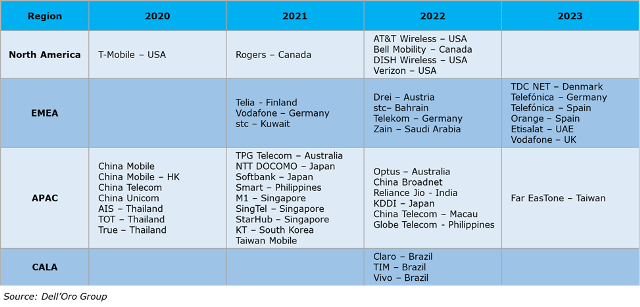The evolution of 5G networks, particularly the transition from Non-Standalone (5G NSA) to Standalone (5G SA), has been significantly influenced by the integration of Artificial Intelligence and Machine Learning (AI/ML), Dave Bolan of Dell’Oro Group, said in its latest report.
 As of 3Q 2023, 45 Mobile Network Operators (MNOs) have launched 5G SA networks, revolutionizing the landscape of mobile communications, Dell’Oro Group said.
As of 3Q 2023, 45 Mobile Network Operators (MNOs) have launched 5G SA networks, revolutionizing the landscape of mobile communications, Dell’Oro Group said.
In 2023, telecom operators such as TDC and NET in Denmark, Telefonica in Germany and Spain, Orange in Spain, Etisalat in UAE, Vodafone in the UK and Far EasTone in Taiwan have launched 5G 5G SA networks in select locations.
But the deployment of 5G SA networks is facing a slow down in terms of number of markets it reached in 2022.
A GSMA report said the percentage of live 5G networks that are 5G SA or planned to become 5G SA is around 50 percent as of Q1 2023. Over the coming years, countries in Europe and North America will likely move to nationwide 5G SA deployments.
The latest GSA report says at least 36 operators in 25 countries and territories have launched or deployed public 5G SA networks.
5G SA networks can be deployed in a variety of scenarios: as an overlay for a public 5G non-SA network, as a greenfield 5G deployment for a public network operator without a separate LTE network, or as a private network deployment for an enterprise, utility, education, government or other organisation requiring its own private campus network.
AI/ML Driving Efficient Operations in 5G Core:
The 5G Core heavily relies on AI/ML to operate efficiently, especially in the context of 5G SA networks. AI/ML plays a pivotal role in automating real-time and near real-time decision-making processes by analyzing vast amounts of raw data from consumer traffic activity, IoT sensors, and other connected devices. One crucial aspect of this is the role of AI/ML in network data analytics performed by the Network Data Analytics Function (NWDAF). The sheer volume of data generated by network functions necessitates the implementation of AI/ML, as manual handling is not feasible, often reaching petabytes in scale.
 Types of AI/ML Applications in NWDAF Data Analytics:
Types of AI/ML Applications in NWDAF Data Analytics:
Several types of AI/ML are employed in NWDAF data analytics, each serving a unique purpose:
Descriptive Analytics: Provides insights into past events and activities.
Diagnostic Analytics: Offers understanding and explanations of why certain events occurred.
Real-time Analytics (On-demand or Streaming Analytics):
Predictive Analytics: Analyzes current and historical data to predict future events.
Prescriptive Analytics: Suggests actions based on predictions.
AI/ML in 5G Computer Vision Application Data Analytics:
Computer Vision, a transformative “killer application,” is significantly enhanced by AI/ML data analytics. It opens doors to various industrial use cases by leveraging high-performance Artificial Intelligence of Things (AIoT) devices. The imminent completion of Proofs of Concepts (PoCs) and trials paves the way for widespread implementation of these solutions at scale, made possible by AI/ML.
The Impact of Generative AI:
Generative AI, a category of AI algorithms generating new outputs based on training data, has transformative potential across multiple domains. It can create fresh content like images, text, audio, and more, revolutionizing content creation and consumption in various industries.
Key Takeaway – AI/ML in the 5G Core:
From creating new content with Generative AI to powering computer vision applications and analyzing 5G network data, AI/ML’s role is fundamental. However, to meet specific latency requirements and keep up with the increasing demand for enhanced applications, more computing power and storage will be necessary at the 5G Core edge, highlighting the importance of Multi-access Edge Computing (MEC).
Baburajan Kizhakedath
